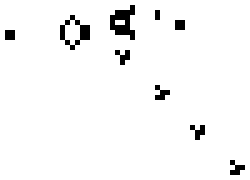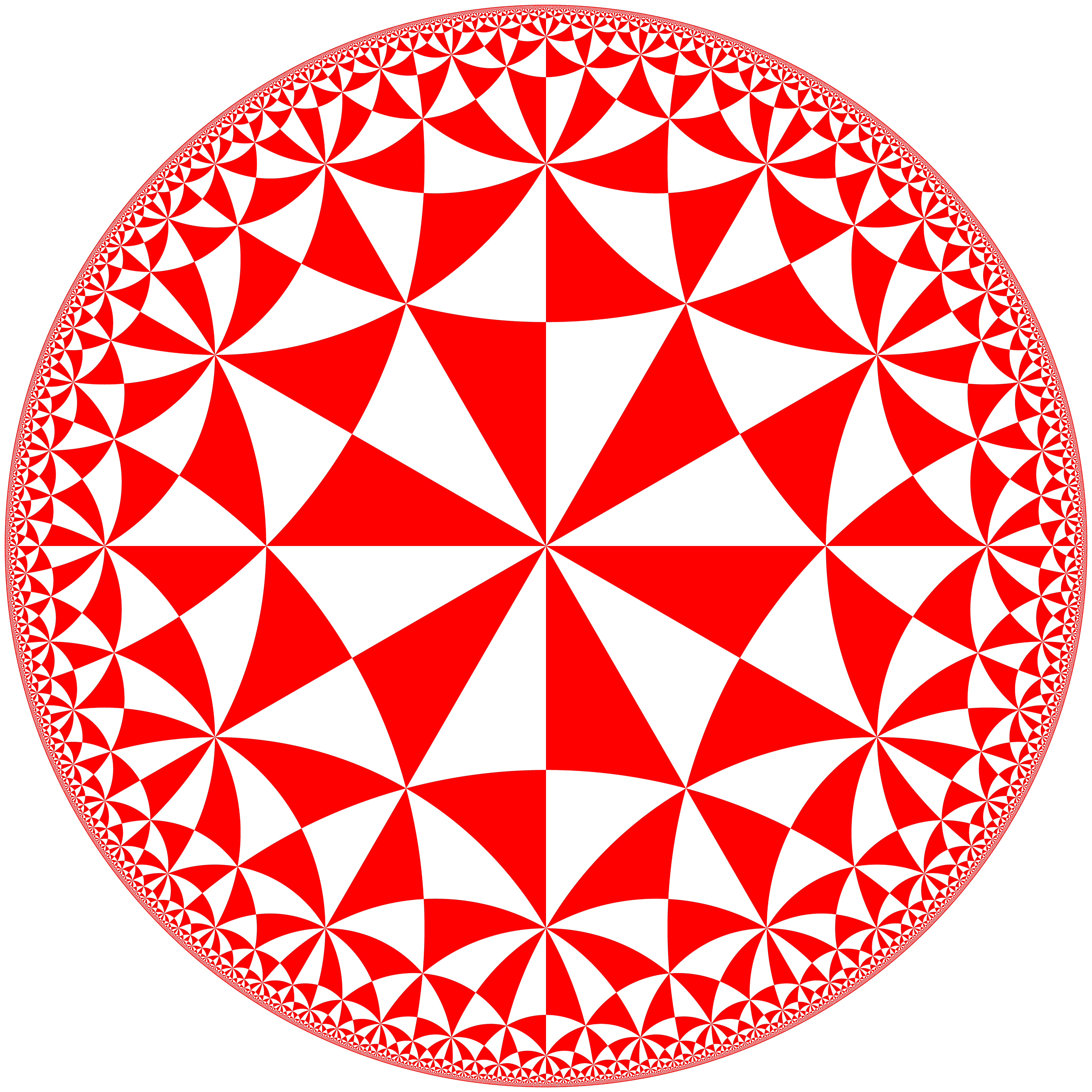 |
Alternated Octagonal Tiling
In geometry, the tritetragonal tiling or alternated octagonal tiling is a uniform tiling of the hyperbolic plane. It has Schläfli symbols of or h. Geometry Although a sequence of edges seem to represent straight lines (projected into curves), careful attention will show they are not straight, as can be seen by looking at it from different projective centers. Dual tiling In art Circle Limit III is a woodcut made in 1959 by Dutch artist M. C. Escher, in which "strings of fish shoot up like rockets from infinitely far away" and then "fall back again whence they came". White curves within the figure, through the middle of each line of fish, divide the plane into squares and triangles in the pattern of the tritetragonal tiling. However, in the tritetragonal tiling, the corresponding curves are chains of hyperbolic line segments, with a slight angle at each vertex, while in Escher's woodcut they appear to be smooth hypercycles. Related polyhedra and tiling See also *' ... [...More Info...] [...Related Items...] OR: [Wikipedia] [Google] [Baidu] [Amazon] |
 |
Geometry
Geometry (; ) is a branch of mathematics concerned with properties of space such as the distance, shape, size, and relative position of figures. Geometry is, along with arithmetic, one of the oldest branches of mathematics. A mathematician who works in the field of geometry is called a ''List of geometers, geometer''. Until the 19th century, geometry was almost exclusively devoted to Euclidean geometry, which includes the notions of point (geometry), point, line (geometry), line, plane (geometry), plane, distance, angle, surface (mathematics), surface, and curve, as fundamental concepts. Originally developed to model the physical world, geometry has applications in almost all sciences, and also in art, architecture, and other activities that are related to graphics. Geometry also has applications in areas of mathematics that are apparently unrelated. For example, methods of algebraic geometry are fundamental in Wiles's proof of Fermat's Last Theorem, Wiles's proof of Fermat's ... [...More Info...] [...Related Items...] OR: [Wikipedia] [Google] [Baidu] [Amazon] |
 |
Woodcut
Woodcut is a relief printing technique in printmaking. An artist carves an image into the surface of a block of wood—typically with gouges—leaving the printing parts level with the surface while removing the non-printing parts. Areas that the artist cuts away carry no ink, while characters or images at surface level carry the ink to produce the print. The block is cut along the wood grain (unlike wood engraving, where the block is cut in the end-grain). The surface is covered with ink by rolling over the surface with an ink-covered roller ( brayer), leaving ink upon the flat surface but not in the non-printing areas. Multiple colours can be printed by keying the paper to a frame around the woodblocks (using a different block for each colour). The art of carving the woodcut can be called ''xylography'', but this is rarely used in English for images alone, although that term and ''xylographic'' are used in connection with block books, which are small books containing text ... [...More Info...] [...Related Items...] OR: [Wikipedia] [Google] [Baidu] [Amazon] |
|
Isogonal Tilings
Isogonal, a mathematical term meaning "having similar angles", may refer to: *Isogonal figure or polygon, polyhedron, polytope or tiling * Isogonal trajectory, in curve theory *Isogonal conjugate __NOTOC__ In geometry, the isogonal conjugate of a point with respect to a triangle is constructed by reflecting the lines about the angle bisectors of respectively. These three reflected lines concur at the isogonal conjugate of . (Th ..., in triangle geometry See also * Isogonic line, in the study of Earth's magnetic field, a line of constant magnetic declination {{disambig Geometry ... [...More Info...] [...Related Items...] OR: [Wikipedia] [Google] [Baidu] [Amazon] |
|
 |
Hyperbolic Tilings
In hyperbolic geometry, a uniform hyperbolic tiling (or regular, quasiregular or semiregular hyperbolic tiling) is an edge-to-edge filling of the hyperbolic plane which has regular polygons as Face (geometry), faces and is vertex-transitive (Transitive group action, transitive on its vertex (geometry), vertices, isogonal, i.e. there is an isometry mapping any vertex onto any other). It follows that all vertices are Congruence (geometry), congruent, and the tessellation, tiling has a high degree of rotational and translational symmetry. Uniform tilings can be identified by their vertex configuration, a sequence of numbers representing the number of sides of the polygons around each vertex. For example, 7.7.7 represents the heptagonal tiling which has 3 heptagons around each vertex. It is also regular since all the polygons are the same size, so it can also be given the Schläfli symbol . Uniform tilings may be Regular polyhedron, regular (if also face- and edge-transitive), quasi- ... [...More Info...] [...Related Items...] OR: [Wikipedia] [Google] [Baidu] [Amazon] |
 |
John Horton Conway
John Horton Conway (26 December 1937 – 11 April 2020) was an English mathematician. He was active in the theory of finite groups, knot theory, number theory, combinatorial game theory and coding theory. He also made contributions to many branches of recreational mathematics, most notably the invention of the cellular automaton called the Game of Life. Born and raised in Liverpool, Conway spent the first half of his career at the University of Cambridge before moving to the United States, where he held the John von Neumann Professorship at Princeton University for the rest of his career. On 11 April 2020, at age 82, he died of complications from COVID-19. Early life and education Conway was born on 26 December 1937 in Liverpool, the son of Cyril Horton Conway and Agnes Boyce. He became interested in mathematics at a very early age. By the time he was 11, his ambition was to become a mathematician. After leaving sixth form, he studied mathematics at Gonville and Caius Coll ... [...More Info...] [...Related Items...] OR: [Wikipedia] [Google] [Baidu] [Amazon] |
|
List Of Regular Polytopes
This article lists the regular polytopes in Euclidean, spherical and hyperbolic spaces. Overview This table shows a summary of regular polytope counts by rank. There are no Euclidean regular star tessellations in any number of dimensions. 1-polytopes There is only one polytope of rank 1 (1-polytope), the closed line segment bounded by its two endpoints. Every realization of this 1-polytope is regular. It has the Schläfli symbol , or a Coxeter diagram with a single ringed node, . Norman Johnson calls it a ''dion'' and gives it the Schläfli symbol . Although trivial as a polytope, it appears as the edges of polygons and other higher dimensional polytopes. It is used in the definition of uniform prisms like Schläfli symbol ×, or Coxeter diagram as a Cartesian product of a line segment and a regular polygon. 2-polytopes (polygons) The polytopes of rank 2 (2-polytopes) are called polygons. Regular polygons are equilateral and cyclic. A -gonal regular polygon is repre ... [...More Info...] [...Related Items...] OR: [Wikipedia] [Google] [Baidu] [Amazon] |
|
 |
Square Tiling
In geometry, the square tiling, square tessellation or square grid is a regular tiling of the Euclidean plane consisting of four squares around every vertex. John Horton Conway called it a quadrille. Structure and properties The square tiling has a structure consisting of one type of congruent prototile, the square, sharing two vertices with other identical ones. This is an example of monohedral tiling. Each vertex at the tiling is surrounded by four squares, which denotes in a vertex configuration as 4.4.4.4 or 4^4 . The vertices of a square can be considered as the lattice, so the square tiling can be formed through the square lattice. This tiling is commonly familiar with the flooring and game boards. It is self-dual, meaning the center of each square connects to another of the adjacent tile, forming square tiling itself. The square tiling acts transitively on the ''flags'' of the tiling. In this case, the flag consists of a mutually incident vertex, edge, and tile ... [...More Info...] [...Related Items...] OR: [Wikipedia] [Google] [Baidu] [Amazon] |
|
Hypercycle (geometry)
In hyperbolic geometry, a hypercycle, hypercircle or equidistant curve is a curve whose points have the same orthogonal distance from a given straight line (its axis). Given a straight line and a point not on , one can construct a hypercycle by taking all points on the same side of as , with perpendicular distance to equal to that of . The line is called the ''axis'', ''center'', or ''base line'' of the hypercycle. The lines perpendicular to , which are also perpendicular to the hypercycle, are called the '' normals'' of the hypercycle. The segments of the normals between and the hypercycle are called the ''radii''. Their common length is called the ''distance'' or ''radius'' of the hypercycle. The hypercycles through a given point that share a tangent through that point converge towards a horocycle as their distances go towards infinity. Properties similar to those of Euclidean lines Hypercycles in hyperbolic geometry have some properties similar to those of lines i ... [...More Info...] [...Related Items...] OR: [Wikipedia] [Google] [Baidu] [Amazon] |
|
 |
Circle Limit III
''Circle Limit III'' is a woodcut made in 1959 by Dutch artist M. C. Escher, in which "strings of fish shoot up like rockets from infinitely far away" and then "fall back again whence they came".Escher, as quoted by . It is one of a series of four woodcuts by Escher depicting ideas from hyperbolic geometry. Dutch physicist and mathematician Bruno Ernst called it "the best of the four".. Inspiration Escher became interested in tessellations of the plane after a 1936 visit to the Alhambra in Granada, Spain,.. and from the time of his 1937 artwork '' Metamorphosis I'' he had begun incorporating tessellated human and animal figures into his artworks. In a 1958 letter from Escher to H. S. M. Coxeter, Escher wrote that he was inspired to make his ''Circle Limit'' series by a figure in Coxeter's article "Crystal Symmetry and its Generalizations". Coxeter's figure depicts a tessellation of the hyperbolic plane by right triangles with angles of 30°, 45°, and 90°; triangles with th ... [...More Info...] [...Related Items...] OR: [Wikipedia] [Google] [Baidu] [Amazon] |